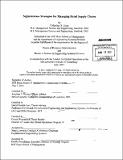Segmentation strategies for managing retail supply chains
Author(s)
Liang, Catherine G. (Catherine Gloria)
DownloadFull printable version (14.88Mb)
Other Contributors
Leaders for Global Operations Program.
Advisor
Jonathan L. Byrnes and David Simchi-Levi.
Terms of use
Metadata
Show full item recordAbstract
High-technology manufacturing companies often face rapid price decline and capacity constraints. Especially in the retail side of the business where the supply chain is much longer and revenue is sometimes not recognized until the sell-through point, optimizing inventory positioning is critical. No longer is a one-size-fits-all approach sufficient; in order to perform optimally, manufacturers should categorize their retailers, stores, and products, and tailor their strategy for each accordingly. This work shows how to use metrics such as gross margin return on inventory investment, models and tools such as assortment, promotional risk, supply chain, and replenishment segmentation to drive improvements in inventory performance and recommends ways to apply them in different retail chains. In particular, three retailer types - discount retailers, specialty retailers, and convenience retailers are discussed.
Description
Thesis (M.B.A.)--Massachusetts Institute of Technology, Sloan School of Management; and, (S.M.)--Massachusetts Institute of Technology, Engineering Systems Division; in conjunction with the Leaders for Global Operations Program at MIT, 2011. Cataloged from PDF version of thesis. Includes bibliographical references (p. 100-101).
Date issued
2011Department
Leaders for Global Operations Program at MIT; Massachusetts Institute of Technology. Engineering Systems Division; Sloan School of ManagementPublisher
Massachusetts Institute of Technology
Keywords
Sloan School of Management., Engineering Systems Division., Leaders for Global Operations Program.